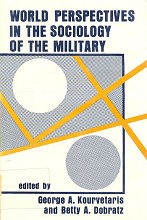
World perspectives in the sociology of the military (fülszöveg)
A truly unique compilation, World Perspectives in the Sociology of the Military explores both age-old and contemporary issues pertaining to the sociology of military institutions and civil-military relations. At the same time it deals with major conceptual, research-empirical, and methodological issues in the field of sociology devoted to military aspects. A concise overview with a sociological-political science framework and a perspective utilizing international factors is provided, along with analyses of the major issues of the internal dynamics of military organizations as these issues are reflected in evolving military organizations around the world. The interrelationship between social and political change and the military, and the way the armed forces responds to and internalizes these changes are also fully treated.
The principal focus is on the concepts of professional and organizational perspectives and of civil-military relations. Comparative international factors are provided by chapters on African, European, Middle Eastern, Latin American, and United States militaries, and also included is a section devoted to the methodological aspects of the measurement of military intervention in developing nations.
In Part I the editors have written an integrated overview and sociological framework for analyzing and critically assessing military sociology. Part II explores the internal dynamics of military organizations, with an emphasis upon professionalism, politics, recruitment, and socialization. Larson first provides an excellent discussion of two major interpretations of military professionalism and civic control. In the following contribution career patterns and occupational structure is the topic, and Lang notes that technological and organizational developments in the U.S. military have led to a shift away from combat orientations to "resource management." While technological change has had important effects on the American military, Garnier warns against generalizing about the effects of technology on other militaries; he argues that changes in the technology can be mediated by cultural and organizational factors. Kourvetaris and Dobratz address themselves to the issues of social recruitment and political orientation of officer corps in fourteen countries; they find that the broadening of the social base of recruitment has not been followed by a concomitant process of political democratization of the officers' political attitudes and/or behavior.
Lucas delineates the nature and content of the military images important in the professional socialization of Army ROTC cadets. Cockerham's research on airborne paratroopers argues against the importance of the socialization process; using interview data, he analyzes the context of airborne socialization in the United States as a status passage.
Ben-Dor outlines a behaviorally oriented theoretical approach to the study of military intervention in the Middle East to begin Part III. Likewise, Thompson advances a synthetic approach for explaining Arab military coups along systemic and subsystemic dimensions of military and civilian structures and regimes. Event data from a number of sub-Saharan African nations were researched by McKown, who suggests analyzing elite political behavior in order to explain the cause of coups d'etat. In particular she recommends further examination of the variables of elite cohesion and coercive ability and potential.
Segal, et al. explore the thesis of convergence and suggest that the emerging pattern for industrial nations of the West may be one of divergence. Convergence can be seen as making the military functionally more independent of its host society and therefore insulated from it. Using Moskos's developmental construct of convergent, divergent, and segmented patterns of civil-military relations, Kourvetaris traces the linkages between armed forces and society in the context of the military role in Greek politics, both in diachronic and synchronic terms.
Drury assesses the effectiveness of military rule in Brazil during 1964–70 and Herspring provides background information on socialist countries, while considering the effect that an increasing reliance on modern technology has had on civil-military relations in East Germany. Sigelman examines five indicators of the extent of military intervention and derives his own Military Intervention Index. The final contribution by Tannahill discusses new operationalism of military intervention and provides an application of this new variable in the context of military intervention in Latin America.